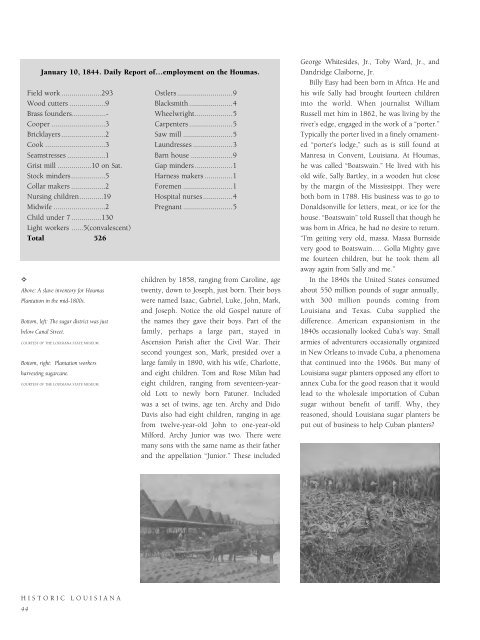Historic Louisiana
An illustrated history of Louisiana, paired with the histories of companies, families and organizations that make the state great.
An illustrated history of Louisiana, paired with the histories of companies, families and organizations that make the state great.
You also want an ePaper? Increase the reach of your titles
YUMPU automatically turns print PDFs into web optimized ePapers that Google loves.
✧<br />
January 10, 1844. Daily Report of…employment on the Houmas.<br />
Field work ....................293<br />
Wood cutters ..................9<br />
Brass founders.................-<br />
Cooper ...........................3<br />
Bricklayers......................2<br />
Cook ..............................3<br />
Seamstresses ...................1<br />
Grist mill .................10 on Sat.<br />
Stock minders.................5<br />
Collar makers .................2<br />
Nursing children............19<br />
Midwife ..........................2<br />
Child under 7 ...............130<br />
Light workers ......5(convalescent)<br />
Total 526<br />
Above: A slave inventory for Houmas<br />
Plantation in the mid-1800s.<br />
Bottom, left: The sugar district was just<br />
below Canal Street.<br />
COURTESY OF THE LOUISIANA STATE MUSEUM.<br />
Bottom, right: Plantation workers<br />
harvesting sugarcane.<br />
COURTESY OF THE LOUISIANA STATE MUSEUM.<br />
Ostlers............................9<br />
Blacksmith ......................4<br />
Wheelwright...................5<br />
Carpenters ......................5<br />
Saw mill .........................5<br />
Laundresses ....................3<br />
Barn house .....................9<br />
Gap minders ...................1<br />
Harness makers ..............1<br />
Foremen .........................1<br />
Hospital nurses...............4<br />
Pregnant .........................5<br />
children by 1858, ranging from Caroline, age<br />
twenty, down to Joseph, just born. Their boys<br />
were named Isaac, Gabriel, Luke, John, Mark,<br />
and Joseph. Notice the old Gospel nature of<br />
the names they gave their boys. Part of the<br />
family, perhaps a large part, stayed in<br />
Ascension Parish after the Civil War. Their<br />
second youngest son, Mark, presided over a<br />
large family in 1890, with his wife, Charlotte,<br />
and eight children. Tom and Rose Milan had<br />
eight children, ranging from seventeen-yearold<br />
Lott to newly born Patuner. Included<br />
was a set of twins, age ten. Archy and Dido<br />
Davis also had eight children, ranging in age<br />
from twelve-year-old John to one-year-old<br />
Milford. Archy Junior was two. There were<br />
many sons with the same name as their father<br />
and the appellation “Junior.” These included<br />
George Whitesides, Jr., Toby Ward, Jr., and<br />
Dandridge Claiborne, Jr.<br />
Billy Easy had been born in Africa. He and<br />
his wife Sally had brought fourteen children<br />
into the world. When journalist William<br />
Russell met him in 1862, he was living by the<br />
river’s edge, engaged in the work of a “porter.”<br />
Typically the porter lived in a finely ornamented<br />
“porter’s lodge,” such as is still found at<br />
Manresa in Convent, <strong>Louisiana</strong>. At Houmas,<br />
he was called “Boatswain.” He lived with his<br />
old wife, Sally Bartley, in a wooden hut close<br />
by the margin of the Mississippi. They were<br />
both born in 1788. His business was to go to<br />
Donaldsonville for letters, meat, or ice for the<br />
house. “Boatswain” told Russell that though he<br />
was born in Africa, he had no desire to return.<br />
“I’m getting very old, massa. Massa Burnside<br />
very good to Boatswain…. Golla Mighty gave<br />
me fourteen children, but he took them all<br />
away again from Sally and me.”<br />
In the 1840s the United States consumed<br />
about 550 million pounds of sugar annually,<br />
with 300 million pounds coming from<br />
<strong>Louisiana</strong> and Texas. Cuba supplied the<br />
difference. American expansionism in the<br />
1840s occasionally looked Cuba’s way. Small<br />
armies of adventurers occasionally organized<br />
in New Orleans to invade Cuba, a phenomena<br />
that continued into the 1960s. But many of<br />
<strong>Louisiana</strong> sugar planters opposed any effort to<br />
annex Cuba for the good reason that it would<br />
lead to the wholesale importation of Cuban<br />
sugar without benefit of tariff. Why, they<br />
reasoned, should <strong>Louisiana</strong> sugar planters be<br />
put out of business to help Cuban planters?<br />
HISTORIC LOUISIANA<br />
44
















